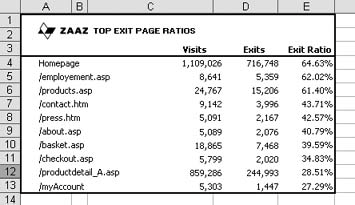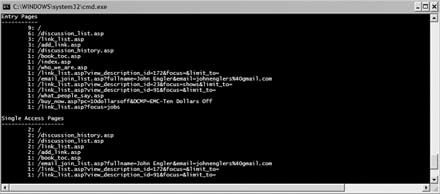Hack58.Use the Entry, Exit, and Single-Access Page Report
Hack 58. Use the Entry, Exit, and Single-Access Page Report
When you boil it down, your ability to understand visitor interaction with individual pages is one of the most important things you'll do with your web measurement application. Knowing where visitors enter and exit your site, and which pages are least engaging, is fundamental to this knowledge. Depending on your site goals, there are a number of different metrics and reports you will want to review. It is however extremely unlikely that you won't take a close interest in your entry pages, exit pages, and single-access pages. No online marketing program is complete without taking a close look at one or all of these page reports, as the information they provide about leakage, slippage, and stickiness in your site is absolutely invaluable. Fortunately, no matter what web measurement tool you are using, these three reports are part of the standard report set. 4.6.1. Entry PagesAn entry pages report displays the most commonly used pages for entering the site. This is the first page that visitors see when they come to your site. Upon reviewing this report, you may be surprised to learn that 100 percent of your site visitors don't enter the site through the home page. In fact, they may not even see the home page at all during their visit. There are a number of reasons why people enter the site through pages other than the home page, including:
From this list, the final entry ("false entries") is the one element that should be of concern to Internet marketers and is worth a deeper look. False entries are usually caused by cached pages, missing tracking (for tag-based solutions), and the technical expiration of a visit when the visitor was still engaged. 4.6.1.1 Page caching.This is a more common problem when analyzing logfiles rather than tracking tags placed on the pages. If a page is not served from the server and you are relying on traditional logfiles, you won't see that first page in the logfiles or web analytics reports. But if the second page is pulled from the web server (not cached), it would look like the second page viewed was the entry page to the site according to your tracking tool. You can avoid this problem by using tracking tags. 4.6.1.2 Missing page tracking tags.There are unique problems when relying on tracking tags to track visitor behavior if they aren't implemented correctly. Often, new pages are launched without the necessary tracking tags. If a site visitor enters the site on a page that is missing tracking tags, the first page he views that does have the tracking tag will show up as his entry page. 4.6.1.3 Expiration of visit session.All tracking tools have a time limit when they end a visit session after no behavior. If you leave your a computer in the middle of a visit, your measurement tool will likely consider your visit over after a certain period of inactivity [Hack #1]. When you return and click a link on the site you were on before, it will consider you as starting a new visit and record you as a new entry. That can help explain why sometimes you see entries behind secure portions of the site that require login. Your tracking tool considers it a new visit, while the web site knows you are still logged in. It is important to understand entries to the site to ensure you are providing the right content and calls to action to the right people based on the top entries. You may also find that people convert on your desired behaviors (sales, leads, etc.) at higher or lower rates, depending on where they enter the site. This can help you identify some of the drivers to those conversion behaviors. 4.6.2. Exit PagesExit pages are the last pages people view before they leave the site. The same principles apply to "false exits," which we described above as "false entries." It is important to understand that all visitors to your site ultimately leave your site, and they have to leave from some page. Also, there are good places and poor places for people to exit the site, based on your overall site goals. It can be misleading to look only at the top few pages listed in the entry and exit page reports. Take a few minutes and compare the top 20 pages viewed on your site and the top 20 exit pages on your site. In many cases, the pages that receive the most traffic also record the highest number of exits. The better way to look at it is to create an exit ratio reporta comparison of page visits to page exits (Figure 4-4). Figure 4-4. Exit page ratio report You can create this report within Excel as part of your normal key performance indicators [Hack #94] and sort the pages on the site from those with the highest exit ratio to the lowest. When looking at the exit ratios, it is helpful to break the pages into different categories. The most common categories include:
Look through the important conversion pages recording high exit ratios and for pages that influence the most site visitors. Focus on improving these pages to reduce the exit ratio. You can strengthen calls to action, improve navigation, and cross sell other content on the site. 4.6.3. Single-Access PagesSingle-access pages are really just a combination of an entry and an exit without viewing any other pages on the site. A page is recorded as a single-access page if a visitor comes to a site, views only one page, and then exits. It is recorded as an entry to the site, an exit from the site, and a single-accesspage visit. These types of pages are almost always recorded by your measurement application and reported in a "single-access page" report (Figure 4-5). Figure 4-5. Single-access pages report These can be a real problem: you have done all the things you need to do to drive people to your site: they come, view one page, and then leave. It is difficult to come up with a scenario when viewing a single page on a site can be considered a positive for the site ownerno matter what your business model. When calculating exit ratios, look at what percentage are single-access pages. You can work to improve these pages the same way you address pages with high exit ratios. You need to move people from those pages recording high single page visits to other pages on your site. We aren't going to eliminate single-access pages all togetherthat is not our intentrather, we are just trying to drive more people further into the site so we have a better chance of convincing them to convert. Unfortunately, many single-access page visits come through search engines, campaigns, and pay-per-click campaigns. And guess whatyou may pay top dollar for those campaign visits that click over once and instantly bail. This is another good reason to track campaign ROI through to conversion rather than just clicks. It is easy to see how these three metrics are related, and the importance of understanding them on their own as well as together. Depending on your site and overall site goals, there are a number of ways you can use this information to improve site performance. 4.6.4. Using All Three Reports TogetherWhile each report is powerful on its own, two very important ratios can be generated on a per-page basis that form useful key performance indicators. 4.6.4.1 Page "stickiness."It is tremendously important to your marketing initiatives that visitors see more than just a single page when they arrive at your site. While looking at your single-access page report is valuable, as is looking at your entry page report, the concept of "stickiness"of a page is another useful way to examine the likelihood that a page is a strong positive contributor to your marketing programs. Calculate page "stickiness"on a page-by-page basis using the following: 1.00 (Single-Access Page Visits / Entry Page Visits) For example, you would determine how many times your home page was the entry page for a visit and the home page was the only page in a visit, and use the above formula to calculate your home page stickiness. Needless to say, the more sticky the page, the more valuable it is. Any landing pages that have a stickiness of less than 40 percent should be closely examined for usability and performance issues. 4.6.4.2 Ratio of page entries to exits.The ratio of entries to exits for a page provides you a rough proxy for the popularity and value of a page. The calculation will yield a ratio between 0.0 and, well, a very large number, depending on the page in question. The lower the number, the less popular the page (e.g., people leave from it more frequently than they arrive at it); the higher the number, the more popular the page. This calculation should be used in the context of the pageask yourself "Does that make sense, given what I hope that visitors do on that page?" If you're looking at your shopping cart "Thank You" page, a very low number would be appropriate (for example, most people will exit the site after making a purchase, and nobody should be entering at that page). Conversely, the higher the better for your home page, although you rarely see exceptionally large numbers on your most generic of all landing pages. While few web measurement applications calculate page stickiness and the ratio of page entries to exits, these views of your page activity are too important to ignore. You should add each of these ratios to your key performance indicators and monitor them frequently. Jason Burby and Eric T. Peterson |
EAN: 2147483647
Pages: 157
